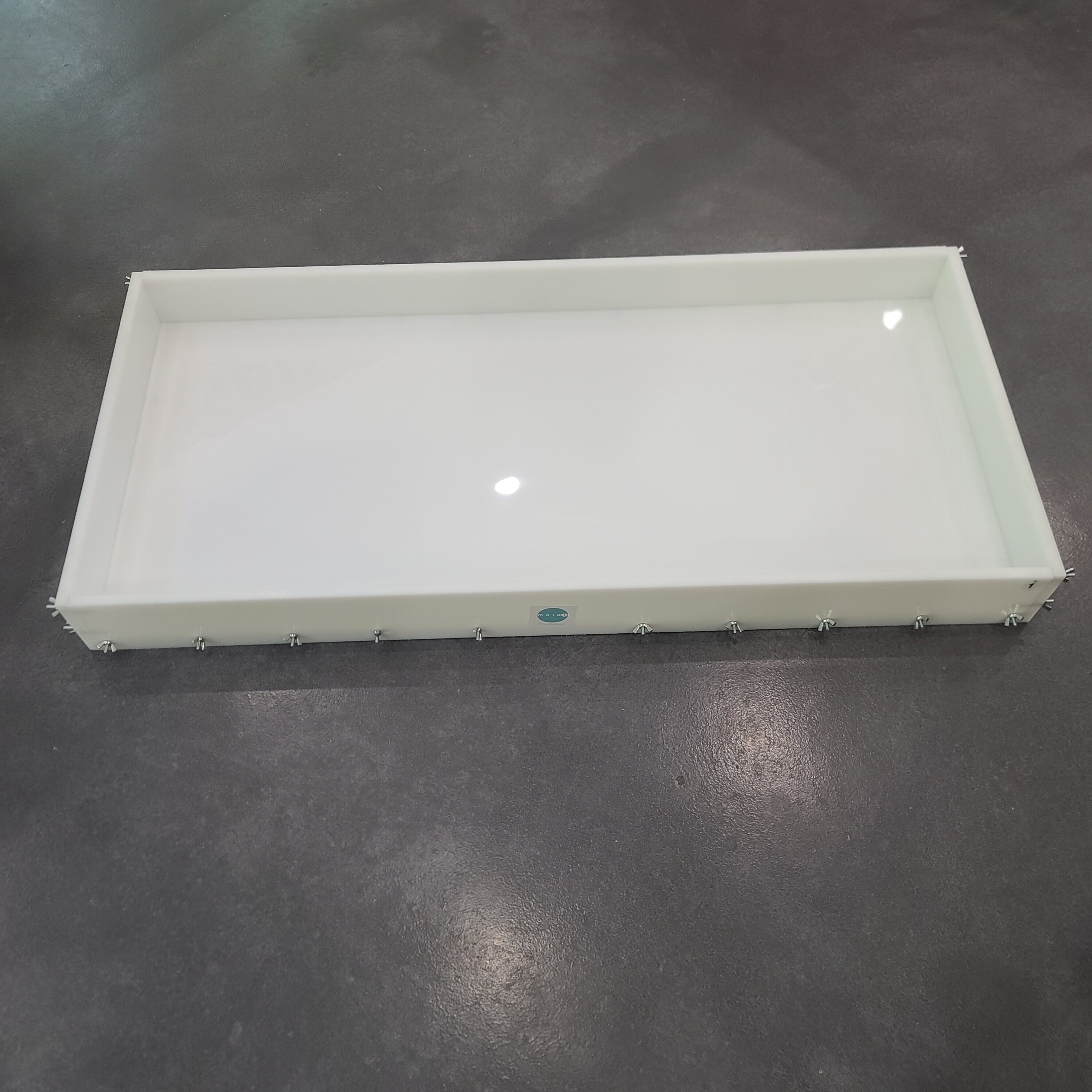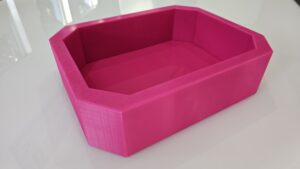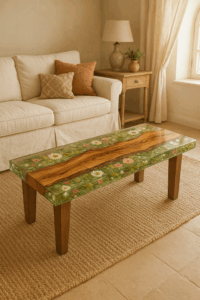Introduction
Creating your own table can be a fun and rewarding DIY project. But if you’re diving into the world of furniture-making, one crucial component you’ll need is the right table mold. Whether you’re looking to craft a stunning floral preservation table or a chic modern design, the table mold you choose can make all the difference. From custom molds to HDPE resin molds, we’ll guide you through selecting the perfect one for your woodworking adventure. Let’s get started!
Understanding Table Mold Materials
 Moldi 18×40 Table Mold
Moldi 18×40 Table Mold
When embarking on a DIY table project, one of the first decisions you’ll face is choosing the right material for your table mold. This choice can significantly impact the ease of your project, the quality of the finished product, and even your budget. Let’s dive into the options so you can make an informed decision!
Overview of Common Mold Materials
There are several materials that people commonly use for table molds:
– Melamine Board: A versatile, composite wood panel coated with a melamine resin-infused paper.
– Silicone: Great for intricate designs due to its flexibility, though it might be too pliable for larger tables.
– PVC: A cost-effective option, but it might not hold up well under heavy use.
– HDPE (High-Density Polyethylene): Increasingly popular for DIY projects, offering a balance of durability and ease of use.
Each material has its pros and cons, and your choice will largely depend on your specific needs and preferences.
Benefits of Using HDPE Resin Molds
Let’s focus on HDPE Resin Molds, which have become a favorite in the world of DIY table making. Here’s why:
– Durability: HDPE is highly resistant to impact and won’t easily warp or crack, ensuring your mold maintains its shape.
– Ease of Release: The non-stick nature of HDPE makes it easy to remove your finished table without damaging the edges.
– Reusability: High-density polyethylene molds can be used multiple times, making them cost-efficient for avid DIY enthusiasts.
Comparing Costs and Durability
When considering a table mold, it’s crucial to balance cost with durability. Typically:
– Melamine Board: may be cost effective for single use, but is difficult to reuse.
– Silicone molds may seem economical, especially for smaller projects, but they lack the longevity needed for repeated use.
– PVC is the cheapest, but you’ll likely need to replace it sooner than HDPE or melamine boards since it easily loses shape.
– HDPE Resin offers a sweet spot: it’s moderately priced and provides superior reusability and durability, making it a smart investment for repeat projects.
Determining the Right Size and Shape
Once you’ve settled on the material, it’s time to think about the size and shape of your mold. Let’s break down what you need to know.
Standard vs. Custom Sizes
Deciding between a standard size or a custom mold can impact both the look of your table and your crafting experience.
– Standard Sizes: These are readily available and can be great for straightforward projects. They save time and are usually more affordable.
– Custom Sizes: If your space requires specific dimensions or if you’re aiming for a unique look, custom-sized molds are the way to go, offering flexibility to fit any design vision.
Choosing the Best Shape for Your Space
When considering the shape of your table mold, think about both aesthetics and functionality:
– Rectangular or Square: Classic shapes that suit most spaces, offering plenty of surface area for activities or dining.
– Round: Perfect for smaller areas or creating a more intimate setting, without corners that take up extra space.
– Oval or Freeform: Excellent for adding an artistic touch and creating a centerpiece that stands out.
Ensuring Adequate Thickness for Stability
Thickness might not be the first thing you think of, but it’s key to ensuring your table is sturdy and durable:
– Too Thin: A thin mold can buckle under the weight of the resin, leading to an unstable and potentially unusable table.
– Just Right: Consider factors like the size of the table and the weight of the materials. A thicker mold offers better support, especially for larger tables, helping your creation stand strong and last longer. For instance, we use 1/2 inch for our standard resin molds and 3/4 for some of our heavy duty and woodworking molds!
Choosing the right table mold is more than just picking a material. It’s about considering your space, style preferences, and the practicality of your design. With these tips in mind, you’re on the right track to crafting a beautiful DIY table that’s uniquely your own.
Customization Options for Table Molds
When it comes to DIY projects, one of the most inviting aspects is the ability to add your own personal touch to every piece. Custom table molds are no exception, offering a world of possibilities for those looking to craft a one-of-a-kind table. Let’s explore some exciting ways to customize your table mold to make it truly your own!
Adding Unique Features
The first step in customizing your table mold is thinking about the unique features you want to include. Do you have a flair for the whimsical? Consider adding built-in decorative elements like swirling currents or marbled effects using HDPE resin, which can capture the look of water ripples or cosmic swirls. These eye-catching designs can make the wood in your project stand out as something truly magnificent.
Ideas for unique features:
– Embedded Objects: Incorporate small treasures like stones, seashells, or colorful beads into the resin.
– Floral Preservation: Preserve delicate flowers or leaves in the tabletop for an elegant, nature-inspired look.
– Lighting: Add LED strips within the mold for a table that literally shines when the lights go out.
– Wood: Who doesn’t like the beauty of some warm, grainy wood!
Incorporating Design Elements
Design elements go a long way in setting your table apart from the rest. Consider the textures, the shapes, and the materials you could use. For example, a geometric-patterned mold can add a modern, edgy twist to your table. If you’re going for a rustic charm, opt for knots and bark edge details that mimic natural wood textures.
Key design considerations include:
– Symmetry vs. Asymmetry: Decide if you want a balanced look or a more dynamic, asymmetrical design.
– Material Combinations: Mix and match different materials for an eclectic appeal—think wood with resin, or metal accents for an industrial vibe.
– Color Coordination: Choose colors that complement the space where your table will reside to create harmony in your decor.
Personalizing Your Table for Style and Functionality
Beyond aesthetics, your customized table mold should also reflect functionality and suit your lifestyle. Think about how the table will be used daily and personalize it to fit that need. For example, if you have kids, consider adding a durable, scratch-resistant surface.
Ways to personalize functionally:
– Adjustable Heights: Opt for molds that allow for different height settings, ideal for transforming your table from a coffee table to a dining table.
– Built-in Storage: Look for designs that allow space for concealed storage, perfect for tidying away magazines, remotes, or dining utensils.
– Edge Treatments: Rounded edges for safety in a household with children or raw edges for a chic, minimalist edge.
Evaluating Supplier Quality
Once you’ve cooked up your grand design for the perfect table, it’s vital to pick the right supplier to bring this vision to life. Quality assurance starts with finding a reliable and reputable source for your table molds. Here’s how to ensure you’re partnering with the best.
Researching Manufacturer Reputation
Your first-point call should be digging into the manufacturer’s reputation. Brands that have been around longer tend to have established credibility. You’ll want to find a supplier known for high-quality products, consistent production standards, and ethical business practices.
Tips for researching reputation:
– Longevity in the Market: A longer time in business often reflects customer satisfaction and stable production standards.
– Social Media Presence: A brand active and engaging on its platforms may provide insights into its community and innovation.
Reading Customer Reviews
Customer reviews can be a treasure trove of information. They give you a firsthand account of what you might expect from a supplier. Look for reviews that talk about the quality, reliability, and any post-purchase experiences.
Strategies for effective review reading:
– Focus on Verified Purchases: These are more likely to give you truthful insights than informal testimonials.
– Look for Trends: One-off complaints might not mean much, but a pattern of issues—like poor customer service or subpar product quality—can be telling.
– Read Both Positive and Negative Reviews: Understand the highlights and potential pitfalls of the product.
Assessing Customer Support and Service
A great product becomes even better with superb customer service. Support before, during, and after your purchase is crucial for a smooth DIY experience, especially if complications arise.
Customer service aspects to consider:
– Response Time: Quick and helpful responses reflect a dedication to customer satisfaction.
– Return and Warranty Policies: Clear and fair policies can save you a lot of hassle if the product doesn’t meet your expectations.
– Technical Support: Access to a knowledgeable support team or resources can be invaluable, especially if you encounter technical challenges.
By considering these customization options and evaluating supplier quality, you’ll be well on your way to creating a stunning DIY table that’s perfect not just for your home, but also for your heart. Happy crafting!
Making the Final Decision
 Image courtesy: Pexels
Image courtesy: Pexels
Choosing the right table mold involves more than just a quick decision—it’s about picking a piece that will define your DIY project’s success. Here are a few pointers to help you confidently make that final choice.
When narrowing down your options, consider the following essential aspects:
– Project Requirements: Reflect on what your table will be used for. Is it for a cozy coffee chat, a family dinner, or a stunning floral preservation piece? Your table’s purpose can significantly influence the type of mold you choose. For instance, a dining table mold might need more durability than a decorative side table mold.
– Material Type: High-Density Polyethylene (HDPE) resin molds are often favored for their easy release and durability. However, if you’re working with wood, choosing woodworking molds that can handle the type of wood you’re using is crucial for achieving a flawless finish.
– Customization Needs: Think about whether you need something that supports a unique design. Custom table molds are great for when you have a specific vision and need a mold to match those dreams. Whether it’s intricate patterns or specific dimensions, having a mold tailored to your desires can make all the difference.
– Ease of Use: Especially if this is your first foray into DIY table projects, select a mold that is user-friendly. Look for molds that are easy to assemble and dismantle, saving you time and frustration.
– Budget Considerations: Lastly, keep your budget in mind. While it might be tempting to go for the most sophisticated mold, remember that there are cost-effective options that won’t compromise on quality.
By reflecting on these factors, you’ll be well on your way to choosing the perfect table mold for your project. Make sure it checks all your boxes, and you’re set to create a masterpiece that stands out and serves its purpose!
Conclusion
Selecting the right table mold is like picking the perfect canvas for your DIY masterpiece. Remember to consider your design and style preferences, the type of project, and the materials you’re using. Don’t forget to take into account the size and shape that best fits your space. With these tips in mind, you’ll be well on your way to creating a unique piece that reflects your creativity and flair. Happy crafting!


